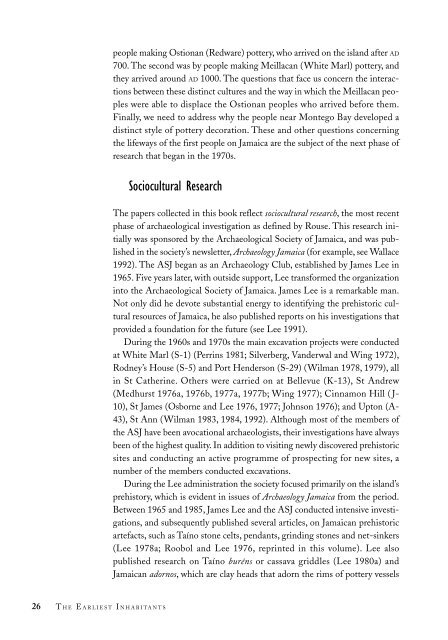The Earliest Inhabitants: The Dynamics of the Jamaican Taino
by Lesley-Gail Atkinson
by Lesley-Gail Atkinson
Create successful ePaper yourself
Turn your PDF publications into a flip-book with our unique Google optimized e-Paper software.
people making Ostionan (Redware) pottery, who arrived on <strong>the</strong> island after AD<br />
700. <strong>The</strong> second was by people making Meillacan (White Marl) pottery, and<br />
<strong>the</strong>y arrived around AD 1000. <strong>The</strong> questions that face us concern <strong>the</strong> interactions<br />
between <strong>the</strong>se distinct cultures and <strong>the</strong> way in which <strong>the</strong> Meillacan peoples<br />
were able to displace <strong>the</strong> Ostionan peoples who arrived before <strong>the</strong>m.<br />
Finally, we need to address why <strong>the</strong> people near Montego Bay developed a<br />
distinct style <strong>of</strong> pottery decoration. <strong>The</strong>se and o<strong>the</strong>r questions concerning<br />
<strong>the</strong> lifeways <strong>of</strong> <strong>the</strong> first people on Jamaica are <strong>the</strong> subject <strong>of</strong> <strong>the</strong> next phase <strong>of</strong><br />
research that began in <strong>the</strong> 1970s.<br />
Sociocultural Research<br />
<strong>The</strong> papers collected in this book reflect sociocultural research, <strong>the</strong> most recent<br />
phase <strong>of</strong> archaeological investigation as defined by Rouse. This research initially<br />
was sponsored by <strong>the</strong> Archaeological Society <strong>of</strong> Jamaica, and was published<br />
in <strong>the</strong> society’s newsletter, Archaeology Jamaica (for example, see Wallace<br />
1992). <strong>The</strong> ASJ began as an Archaeology Club, established by James Lee in<br />
1965. Five years later, with outside support, Lee transformed <strong>the</strong> organization<br />
into <strong>the</strong> Archaeological Society <strong>of</strong> Jamaica. James Lee is a remarkable man.<br />
Not only did he devote substantial energy to identifying <strong>the</strong> prehistoric cultural<br />
resources <strong>of</strong> Jamaica, he also published reports on his investigations that<br />
provided a foundation for <strong>the</strong> future (see Lee 1991).<br />
During <strong>the</strong> 1960s and 1970s <strong>the</strong> main excavation projects were conducted<br />
at White Marl (S-1) (Perrins 1981; Silverberg, Vanderwal and Wing 1972),<br />
Rodney’s House (S-5) and Port Henderson (S-29) (Wilman 1978, 1979), all<br />
in St Ca<strong>the</strong>rine. O<strong>the</strong>rs were carried on at Bellevue (K-13), St Andrew<br />
(Medhurst 1976a, 1976b, 1977a, 1977b; Wing 1977); Cinnamon Hill ( J-<br />
10), St James (Osborne and Lee 1976, 1977; Johnson 1976); and Upton (A-<br />
43), St Ann (Wilman 1983, 1984, 1992). Although most <strong>of</strong> <strong>the</strong> members <strong>of</strong><br />
<strong>the</strong> ASJ have been avocational archaeologists, <strong>the</strong>ir investigations have always<br />
been <strong>of</strong> <strong>the</strong> highest quality. In addition to visiting newly discovered prehistoric<br />
sites and conducting an active programme <strong>of</strong> prospecting for new sites, a<br />
number <strong>of</strong> <strong>the</strong> members conducted excavations.<br />
During <strong>the</strong> Lee administration <strong>the</strong> society focused primarily on <strong>the</strong> island’s<br />
prehistory, which is evident in issues <strong>of</strong> Archaeology Jamaica from <strong>the</strong> period.<br />
Between 1965 and 1985, James Lee and <strong>the</strong> ASJ conducted intensive investigations,<br />
and subsequently published several articles, on <strong>Jamaican</strong> prehistoric<br />
artefacts, such as Taíno stone celts, pendants, grinding stones and net-sinkers<br />
(Lee 1978a; Roobol and Lee 1976, reprinted in this volume). Lee also<br />
published research on Taíno buréns or cassava griddles (Lee 1980a) and<br />
<strong>Jamaican</strong> adornos, which are clay heads that adorn <strong>the</strong> rims <strong>of</strong> pottery vessels<br />
26 T HE E ARLIEST I NHABITANTS


















